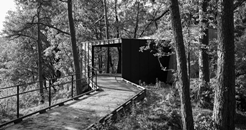 Can being in nature speed up healing?
Can being in nature speed up healing?
Apolitical reports that at Oslo University Hospital, sick kids aren’t confined to bed. They fish, chop wood, shoot arrows and paint pictures, all in a woodland cabin 650 feet from the building.
This outdoor care centre is called Friluftssykehuset — in Norwegian, friluftsliv translates to “being out in nature”, and sykehus means “hospital” — and it’s part of an experiment to see if nature can speed up healing. It’s an idea grounded in research: multiple studies have shown that spending time outside can decrease stress and improve both mental and physical health. Others suggest that physical activity can prevent illness and mental disorders, and help those affected by trauma heal.
“Bringing patients outside the hospital helps them relax and find the strength to get through their treatment,” said child psychiatrist Maren Østvold Lindheim, who helped spearhead the idea. “Being in nature gives them the feeling of possibility: they have more energy, more hope and more creativity.”
Lindheim and her colleagues had been bringing patients into the woods near Oslo University Hospital for years. It started with just a few children at a time — soon, they were bringing groups into the forest to build fires and canoe on a nearby lake. But only children who were well enough could participate in these trips. With the cabin, the hospital can now give all children the feeling of being away from the hospital, minutes from its premises.
Lindheim and her colleagues plan to document the results of their research into how nature affects sick children, in order to inform how other hospitals can help young patients. The physicians will experiment with different ways to use nature in treatment.
Read the full article here.
Does other evidence support this approach?
In a study from the University of Illinois, it was found that healthcare costs tend to be lower in counties with more forests and shrub-lands than in counties dominated by other types of land cover. The relationship persists even when accounting for economic, geographic or other factors that might independently influence health care costs, researchers report.
The study also found that increases in forest and shrub cover corresponded to decreases in health care spending. No such relationship was found with other types of vegetative land cover, however.
The findings, reported in the journal Urban Forestry and Urban Greening, adds to a growing body of evidence linking green space – in particular, forested areas – to better health outcomes for those living nearby.
Previous studies have shown that people in intensive care units recover more quickly and have fewer complications after surgery if their hospital rooms look out over trees rather than parking lots. Other studies have found that forest walks can influence potentially health-promoting hormone levels or anti-cancer immune cells in the blood.
The healthcare savings add up to billions of dollars annually in the USA.
Read the full article here.
I'm not going New Age here! Just pointing out another environmental benefit that we would do well to preserve and develop - especially in urban areas.
Retweet about this article:
From various articles, 29/05/2019